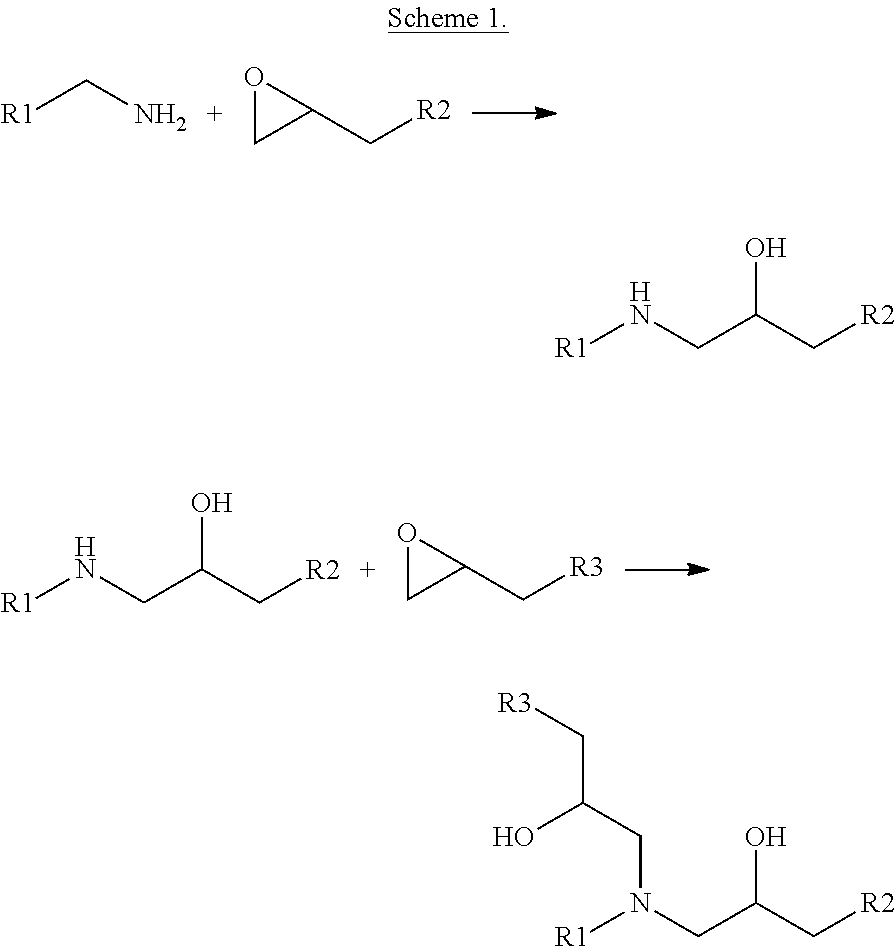Solvent resistant thin film composite membrane and its preparation
a thin film composite membrane and solvent-resistant technology, applied in membrane technology, membrane filtration, reverse osmosis, etc., can solve the problems of relatively poor performance and/or stability of the membrane in organic solvents, not widely applied for the separation of solutes, and dramatic reaction slowdown, etc., to achieve high efficiency
- Summary
- Abstract
- Description
- Claims
- Application Information
AI Technical Summary
Benefits of technology
Problems solved by technology
Method used
Image
Examples
example 1
[0068]An 18 wt % P1700 polysulfone (Sigma Aldrich) solution in NMP (Across) was prepared. The solution was cast onto a porous non-woven PP / PE substrate (Novatex 2471, Freudenberg). The cast membrane was solidified in a coagulation bath containing demineralized water. The obtained support membranes were immersed in 2 w / v % hexanediamine (HDA) in water for 1 h. Afterwards, the immersed membrane was placed in an IFP set-up where it was brought into contact with 2 w / v % neopentylglycol diglycidyl ether (NPG) in hexane for 2 days. Filtration with 35 μM rosebengal in water are summarized in table 1.
TABLE 1MembranePermeation (L / m2bar · h)Rejection (%)2 w / v % HDA-2 w / v % NPG0.256.3
example 2
[0069]An 14 wt % polyimide Matrimid (Lindberg & Lund AS) solution in NMP and THF (3 / 1) (Across) was prepared. The solution was cast onto a porous non-woven PP / PE substrate (Novatex 2471, Freudenberg). The cast membrane was solidified in a coagulation bath containing a solution of hexanediamine in demineralized water for 2.5 hours for crosslinking of support layer and subsequent impregnation for IFP. Afterwards, the immersed membrane was placed in an IFP set-up where it was brought into contact with 2 w / v % bisphenol-A-diglycidylether for 48 h under N2-atmosphere. Just before filtration the membranes were washed with water. Filtration-results with 35 μM rosebengal in water are summarized in table 2.
TABLE 2Hexanediamine (wt %)Permeation (L / m2bar · h)Rejection (%)20.003697.250.002094.5100.001290
example 3
[0070]An 14 wt % polyimide Matrimid (Lindberg & Lund AS) solution in NMP and THF (3 / 1) (Across) was prepared. The solution was cast onto a porous non-woven PP / PE substrate (Novatex 2471, Freudenberg). The cast membrane was solidified in a coagulation bath containing a solution of hexanediamine in demineralized water for 2.5 hours for crosslinking of support layer and subsequent impregnation for IFP. Afterwards, the immersed membrane was placed in an IFP set-up where it was brought into contact with 2 w / v % bisphenol-A-diglycidylether for 48 h under N2-atmosphere. Just before filtration the membranes were washed with water. Filtration-results with 35 μM methylorange in water are summarized in table 3.
TABLE 3Hexanediamine (wt %)Permeation (L / m2bar · h)Rejection (%)20.003696.650.001696.3100.000993.5
PUM
| Property | Measurement | Unit |
|---|---|---|
| organic | aaaaa | aaaaa |
| polar aprotic | aaaaa | aaaaa |
| molecular weights | aaaaa | aaaaa |
Abstract
Description
Claims
Application Information
 Login to View More
Login to View More - R&D
- Intellectual Property
- Life Sciences
- Materials
- Tech Scout
- Unparalleled Data Quality
- Higher Quality Content
- 60% Fewer Hallucinations
Browse by: Latest US Patents, China's latest patents, Technical Efficacy Thesaurus, Application Domain, Technology Topic, Popular Technical Reports.
© 2025 PatSnap. All rights reserved.Legal|Privacy policy|Modern Slavery Act Transparency Statement|Sitemap|About US| Contact US: help@patsnap.com



